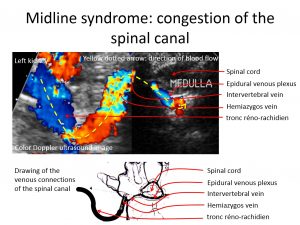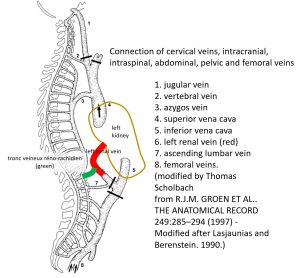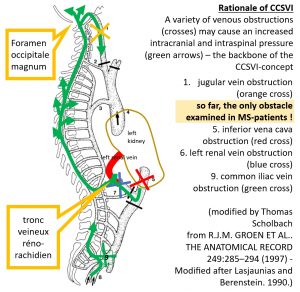- New stuff to read and discuss
- What patients say
- Clinic / online appointments
- Why the diagnosis of a psychosomatic illness is often a misdiagnosis
- Vascular Compression Syndromes
- Do you have questions?
- Checklist vascular compression syndromes
- Description of your symptoms
- Researchers from the Mayo Clinic confirm my concept of the Midline Congestion Syndrome
- Explanation of gender-specific differences in the clinical symptoms of abdominal vascular compression syndromes: varicocele and penile/testicular pain – their main manifestation in men.
- Varicocoele is predominantly caused by left renal vein compression
- Musculoskeletal pecularities of female puberty
- Lordosis /Swayback- Origin of many abdominal compression syndromes
- Bending of a straight vein compels its narrowing
- The lordogenetic midline congestion syndrome
- Neurological consequences of the midline congestion syndrome
- Successful treatment of a teenage girl who was unable to eat due to extreme postprandial pain and unable to walk due to spasticity in her left leg
- Severe ataxia in a young woman with severe spinal congestion – complete resolution after decompression of the left renal vein
- All compression syndromes are one: the spectrum of lordogenetic compressions
- Nutcracker-Syndrome is a misnomer! Lordogenetic left renal vein compression is a more appropriate name!
- May-Thurner-constellation (May-Thurner-syndrome, Cockett’s syndrome)
- Midline (congestion) syndrome
- Pelvic congestion syndrome
- Celiac Trunk Compression / Dunbar syndrome / MALS / Arcuate ligament syndrome
- Wilkie-Syndrome / Superior-mesenteric-artery-syndrome
- Compression of the vena cava inferior
- Evlauation of vascular compressions with the PixelFlux-method
- Connective tissue disorders predispose to multiple compressions
- Postural tachycardia syndrome (POTS) – the hemodynamic consequence of vascular compression syndromes and loose connective tissue
- Restless legs-a little known symptom of abdominal vascular compression syndromes
- Pudendal neuralgia in vascular compression syndromes
- A new sonographic sign of severe orthostatic venous pooling
- Migraine and Multiple Sclerosis
- Hemodynamic effect on cerebral perfusion in patients with multiple localised vascular compression.
- Treatment of vascular compression syndromes
- Fatal errors in the treatment of vascular compression syndromes
- Risks of stents in venous compression syndromes
- Surgical treatment of abdominal compression syndromes: The significance of hypermobility‐related disorders
- Nutcracker and May-Thurner syndrome: Decompression by extra venous tube grafting and significance of hypermobility related disorders
- Our surgical treatment of vascular compressions
- Chronic regional pain syndrome (CRPS) caused by venous compression and mechanical irritation of the coeliac plexus
- Vascular compression syndromes I recently detected
- Kaleidoscope of instructive cases
- Ultrasound Diagnostics
- Profile
- Functional colour Doppler ultrasound – how I do it
- Perfusion Measurement – PixelFlux-method
- Research
- Publications
- Nutcracker and May-Thurner syndrome: Decompression by extra venous tube grafting and significance of hypermobility related disorders
- Papers authored by Th. Scholbach
- Publications
- Inauguration of measurements of the tissue pulsatility index in renal transplants
- From nutcracker phenomenon to midline congestion syndrome and its treatment with aspirin
- First sonographic tissue perfusion measurement in renal transplants
- First sonographic bowel wall perfusion measurement in Crohn disease
- First sonographic renal tissue perfuison measurement
- First sonographic measurement of renal perfusion loss in diabetes mellitus
- PixelFlux measurements of renal tissue perfusion
- Why I prefer not to publish in journals but in the Internet
- Vessel stretching in nephroptosis – an important driver of complaints
- Publications
- Expertise
- Bornavirus Infection
- Scientific cooperation
- Cookie Policy
- Data protection
- Cookie Policy (EU)
- Impressum

Migraine and Multiple Sclerosis
The causes of both migraine and multiple sclerosis are diverse and largely unknown.
Already in 2007, I inaugurated the concept of a connection of the midline congestion and migraine (Scholbach T. From the nutcracker-phenomenon of the left renal vein to the midline congestion syndrome as a cause of migraine, headache, back and abdominal pain and functional disorders of pelvic organs. Med Hypotheses. 2007; 68(6):1318-27).
Scholbach From nutcracker phenomenon to midline congestion syndrome and treatment with aspirinThe rationale for this concept is the increased intraspinal pressure in left sided venous congestion. In venous compression syndromes of the abdomen the lordosis prevents a normal passage of blood across the midline in large veins, which have to cross the midline from left to right.
Within the abdominal cavity these are 3 large veins:
- the left renal vein
- the left common iliac vein
- the splenic vein
If the blood cannot pass through these veins, a pressure builds up in those part of the veins which are left to the spine. These parts dilate and may transform into varicose veins. Smaller veins which transport blood from other organs towards these large veins consequently become pressurized to the same extent as the larger congested veins.
Since the blood flow always follows a route from high pressure to low pressure regions, the blood flow within such tributaries may change its direction. So called collateral pathways develop. These collateral pathways try to transport the blood back to the heart across organs which usually pour their blood into the above-mentioned veins (left renal, left common iliac, splenic).
One possible collateral route is through the spinal canal.
The influx of additional blood volume into the spinal canal produces a variety of symptoms. Among these are back ache, sciatica, lumbar pain, neck pain, tingling and numbness of the fingers and toes, a weakness of the arms and the legs (which may even progress to full paralysis and wheelchair-dependency) and predominantly headaches and migraine.
Only recently a scientific study of pelvic congestion syndrome, which is a consequence of the outflow obstruction of the left common iliac vein and the left renal vein, revealed the exceptionally high prevalence of migraine in patients with pelvic congestion. As a prove of the causal relationship of venous congestion and migraine the migraine disappeared after successful treatment of the pelvic congestion:
Migraine: A Common and Unknown Symptom of Pelvic Congestion Syndrome
Rodolfo Rosenberg and Manuel Menes /Journal of Vascular Surgery: Venous and Lymphatic Disorders; Volume 8, Issue 2, March 2020, Page 317
Migraine A Common and Unknown Symptom of Pelvic Congestion SyndromeSo, if you are suffering from severe migraine, you may benefit from a thorough diagnostics of vascular compression syndromes. The diagnosis of such a compression syndrome may open the way for a causal treatment of your migraine and tension headaches.
If you want to discuss your findings, email me.
The concept of Multiple Sclerosis caused by CCSVI
According to the concept of chronic cerebrospinal venous insufficiency (CCSVI), the venous congestion of the brain and the spinal cord may contribute to or even cause the development of inflammatory foci of the multiple sclerosis. Up to now, only constrictions (stenoses or obliterations) and refluxes of the blood flow in the veins of the neck have been regarded as triggers. Investigations of different centers often could not confirm the diagnostic criteria of CCSVI!
However, the venous pressure in the brain and spinal canal can be significantly increased by the inflow of blood from the pelvic veins and the left renal vein.
From my own experience with patients with multiple sclerosis (MS) I know that this mechanism can be detected in these patients by color Doppler sonography and the PixelFlux technique. It is therefore reasonable to extend the concept of CCSVI to include the examination of the veins of the abdominal cavity and the pelvis.
So if you suffer from multiple sclerosis and symptoms of venous congestion in the abdomen or pelvis, I recommend a colour duplex sonographic examination of all abdominal compression syndromes with the PixelFlux technique.



